Editorial Note: Lady Freethinker thanks Action for Primates and Dr. Nedim Buyukmihci for their assistance in reviewing a part of the protocol procedures in these highly invasive experiments.
Rhesus macaques are being forcibly addicted to alcohol — including via catheters invasively anchored into their stomachs — at the University of Mississippi Medical Center (UMMC), according to documents obtained by Lady Freethinker through a public records request.
The studies have been ongoing for at least 15 years and have consumed more than $1.8 million in taxpayer-supported funding since 2020 — with no direct clinical applications to date.
The UMMC, which maintains a colony of more than 100 macaques for use in experiments and reports having a “strong commitment to laboratory animal-based research,” did not immediately respond to media inquiries.
But in a grant application to the National Institute on Alcohol Abuse and Alcoholism (NIAAA), researchers wrote that while there are already medications and behavioral therapies known to successfully treat human alcohol-related disorders, “no universally effective strategy has been identified.”

(NIH RePorter/NIAAA; Emphasis: LFT)
Meanwhile, monkeys are languishing in cages outfitted with levers that they press to directly inject alcohol into their bodies or drinking panels they can use to self-administer alcohol — with “training” sessions lasting for hours, according to the public records documents.
To cope, ten of the monkeys being forcibly exposed to alcohol have turned to self-injurious behavior (denoted by researchers as “SIB”), including biting themselves, and other abnormal behaviors — including pacing, self-grasping, grinding their teeth, and saluting — that primate experts have long-recognized as symptoms of extreme psychological distress.
These ten monkeys — whose names are Mendel, Affen, Popcorn, Fly, Rooster, Louis, Farley, Goldie, Mourinho, and Finch — also have experienced other issues, with their records showing hair loss, nosebleeds, dermatitis, loose teeth, abrasions, wounds, lesions, vomiting, low body temperatures, swellings, agitation, and nausea, according to records obtained by LFT through a public records request.
The experiments currently are funded and scheduled through at least July 31, 2025.
Formerly, UMMC was officially warned by the U.S. Department of Agriculture (USDA) in April 2023 over inadequate personnel qualifications and accidental injuries to three primates who escaped their enclosures and wound up with injuries, some of which required “tissue” glue and surgery and all of which the USDA determined had resulted from a “lack of employee training.”
Lady Freethinker is calling for an end to these invasive and expensive experiments and for researchers to instead forge forward with human biology-based research — which has proven safer, more reliable, and more cost-effective for suffering humans who need effective treatments now.
Training $7,500 Rhesus Macaques To Drink Alcohol
In their grant application to the NIAAA, researchers noted that most providers treating Alcohol Use Disorder (AUD) in patients typically turn to pharmacotherapies — or drugs — as a last resort.
“Pharmacotherapies typically are one of the last options to be offered to the AUD patient; rather, behavioral therapies are the approach of choice,” they wrote.
Still, they told funders that they wanted to see whether deploying a range of substances to certain receptor sites in the body could alter the impacts of alcohol — and they wanted to use rhesus macaques to do it.
Researchers wrote that a single rhesus monkey typically costs $7,500 and that over three years they were looking to purchase 15 — for an estimated $112,500 — from domestic breeding colonies at the Wisconsin, Oregon, and California National Primate Research Centers. They also said that given a 12-18 month wait list for monkeys, they would need to resort to using macaques from their own colony who had previously been used in other experiments.
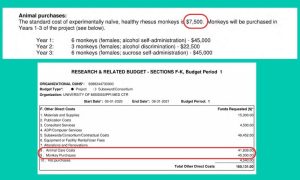
(Courtesy of NIAA; Emphasis: LFT)
Researchers detailed using at least 30 macaques and 84 rats to conduct their experiments — which involved forcing many of the animals to consume alcohol and “training” several other groupings of the animals to self-administer alcohol, per the experiment protocol.
Several of the groupings started with highly invasive surgeries, in which researchers cut through the abdominal cavities of anesthetized monkeys and implanted catheters in their stomachs so that the monkeys — when awake — could push a lever in their cage and have alcohol or a sugar solution pumped directly into their stomachs, and so that the researchers also could force these substances into the monkeys. Another group of monkeys would be in cages with drinking panels, from which they could self-administer alcohol.
Some of the groupings involved daily sessions lasting up to three hours or until monkeys had consumed a “pharmacologically relevant alcohol dose.” Another grouping involved seeing what would happen when alcohol-exposed monkeys were deprived of alcohol.
Researchers wrote that the surgeries could result in “discomfort, distress, or pain” to the monkeys and also noted that during “trainings” — in which monkeys were given food pellets for doing what the researchers wanted them to do — the monkeys may at times be too impaired from the drug dosage to successfully press the levers.
Other expected side effects included sedation, poor muscle control, and anxiety, per the protocol.
In a progress report for the first year of a grant cycle, researchers wrote that their “accomplishment” was training five monkeys to drink alcohol of their own volition, using training and polydipsia — or inducing extreme thirst in the monkeys.
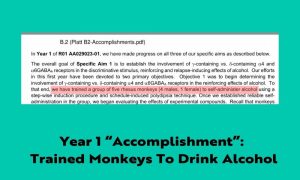
(Courtesy of NIAAA; Emphasis: LFT)
The researchers also noted they were going to train rats to self-administer alcohol and then deprive some of them of the drug for weeks at a time. At the study’s end, the monkeys would be recycled into other experiments, while all the rats would be killed, according to the protocol.
Although numerous scientific studies and failed drug trials have shown that results in nonhuman animals cannot safely and reliably translate to treatments for humans, researchers told the NIAAA that the monkeys and rats were “needed” because doing the tests on humans would be unethical.
“The proposed work cannot be conducted in humans because of the addictive and/or experimental nature of the drugs under study,” the researchers said in their grant application.
The UMMC did not respond to media inquiries about how the experiments would account for the complexity of addiction or human-specific factors that can lead to alcohol consumption and addiction — including genetic predispositions to alcoholism, financial woes, work-related stress, or social pressure to drink.
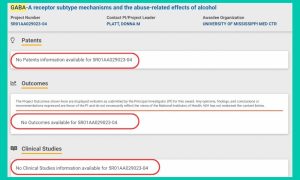
(NIH RePorter; Emphasis: LFT)
Alcohol-Exposed Monkeys Show Self-Harm and Other Signs of Severe Psychological Distress
Through a public records request, Lady Freethinker obtained a year’s worth of welfare records for 10 primates who had been exposed to alcohol.
In that single year, every single monkey self-harmed or showed other signs of distress, including alopecia — or hair loss.
Here are the monkeys. And here’s how they suffered.
FARLEY
Farley’s records note he suffered from numerous instances of self-harming and other abnormal behaviors in the one-year period covered by LFT’s records request. Researchers observed Farley pacing in his enclosure, biting himself, and demonstrating another abnormal behavior called a “salute” — in which primates place their hand in front of their face with the palm out and press one or more fingers against their eyeball. They also reported patchy alopecia and hair loss on his arms, head, tail base, and back on several occasions and classified his body condition score on several different dates as 2 or 2.5 — or “very thin.” They described him as “excitable” and noted that he was “wasting food” — with plans to “reduce foods to identify preference (in the) upcoming week” despite the primate’s reportedly malnourished state at the time. They also recorded an instance of Farley vomiting in his enclosure.
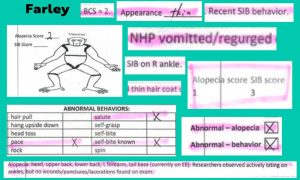
Excerpts From Farley’s Records (Courtesy of University of Mississippi Medical Center; Emphasis: LFT)
MENDEL
Mendel’s records indicated self-injurious behavior (SIB) on at least 10 different dates in the single year of his records that we obtained. Researchers observed him biting his feet and also recorded that he suffered from nosebleeds — including a 3-day duration nosebleed, with active bleeding for about 15 minutes at least one time, that researchers wrote they suspected was due to “Bloody Nose Syndrome” and Moraxella, a bacteria that can cause infections. He also suffered from dermatitis underneath a collar that researchers forced him to wear as part of a sleep study group. Researchers reported his body score condition as 3 — or “thin.”

Excerpts From Mendel’s Records (Courtesy of University of Mississippi Medical Center; Emphasis: LFT)
POPCORN
Popcorn’s records include documented instances of teeth grinding, self-biting, and the abnormal behavior of saluting. Popcorn also suffered from an abrasion, thinning hair, tartar, a degloving wound, and receding gums, according to his records.
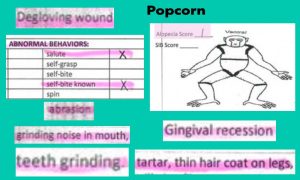
Excerpts From Popcorn’s Records (Courtesy of University of Mississippi Medical Center; Emphasis: LFT)
MOURINHO “MO”
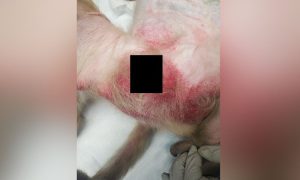
Mo (Courtesy of University of Mississippi Medical Center; Redaction of Genital Area: Lady Freethinker)
Mourinho, also referred to as “Mo,” suffered from patchy alopecia and thinning hair all over his body or an Alopecia Score of 4 at least seven times in the single year of his welfare records that LFT obtained. Researchers described him as “passive” and also reported a body condition score of 3 — or “Thin” — at several points in his records. They also reported that Mo was observed biting himself and recorded several instances during protocols where the monkey’s body temperature dropped to levels where they needed to use heaters to bring his temperature back to normal. Researchers also noted in his records that Mo had a “slow prolonged recovery” from anesthesia and appeared “lethargic” and “cool to the touch.” This monkey also suffered from edema (swelling), tartar, and a lesion, according to his records.
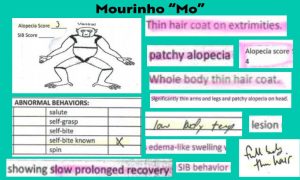
Excerpts From Mourinho’s Records (Courtesy of University of Mississippi Medical Center; Emphasis: LFT)
AFFEN
Affen suffered from numerous instances of patchy alopecia to his arms, legs, and back. He also has a history of harming himself, including biting himself. Researchers also noted he had a loose tooth remnant that needed to be extracted and described him as a “passive” monkey.
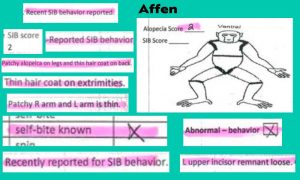
Excerpts From Affen’s Records (Courtesy of University of Mississippi Medical Center; Emphasis: LFT)
LOUIS
Louis was described by researchers as a “passive” male monkey who would at times ask for attention, according to his records. He suffered from numerous instances of hair loss on his arms and legs and also had a history of self-injuring — including biting himself.

Excerpts From Louis’s Records (Courtesy of University of Mississippi Medical Center; Emphasis: LFT)
ROOSTER
Researchers described Rooster as a “passive” male who suffered from numerous bouts of patchy and thinning hair loss on his arms and legs. They also noted the monkey suffered from bloody nasal discharge at one point, as well as tartar and teeth staining. Rooster also was noted “self-grasping,” which researchers noted was abnormal behavior.
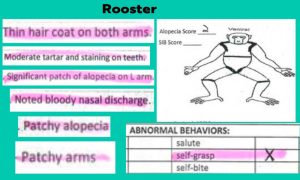
Excerpts From Rooster’s Records (Courtesy of University of Mississippi Medical Center; Emphasis: LFT)
FLY
Researchers described fly as a “passive” monkey who suffered from numerous incidences of patchy hair loss on his arms and leg. Fly also self-injured by biting himself. His records also indicate he had moderate tartar build up and a lesion on his right cheek bone.
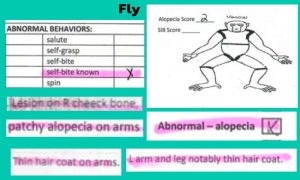
Excerpts From Fly’s Records (Courtesy of University of Mississippi Medical Center; Emphasis: LFT)
GOLDIE
Goldie had noted hair loss on her back after researchers forced her to wear a monkey jacket as part of the protocol, as well as hair loss on her arms. They also noted she had a body score condition of 3 — which they denoted as “thin” — and referenced weight loss in her records.

Excerpts From Goldie’s Records (Courtesy of University of Mississippi Medical Center; Emphasis: LFT)
FINCH
Finch’s records show that he suffered from thinning hair as well as inflammation, an abrasion, tartar, and staining on his teeth. Researchers also described his behavior as abnormal — noting the monkey was agitated — and suffered from a decreased appetite at one point. They also noted that Finch had a history of “possible nausea” after they sedated him as part of the protocol.
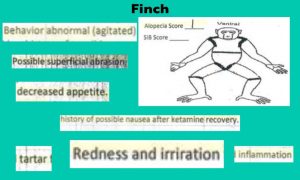
Excerpts From Finch’s Records (Courtesy of University of Mississippi Medical Center; Emphasis: LFT)
TAKE ACTION
Monkeys don’t deserve to be forcibly addicted to alcohol and left to languish in laboratory cages. Please take action today for these suffering macaques by signing our petition calling for an end to these cruel experiments!


